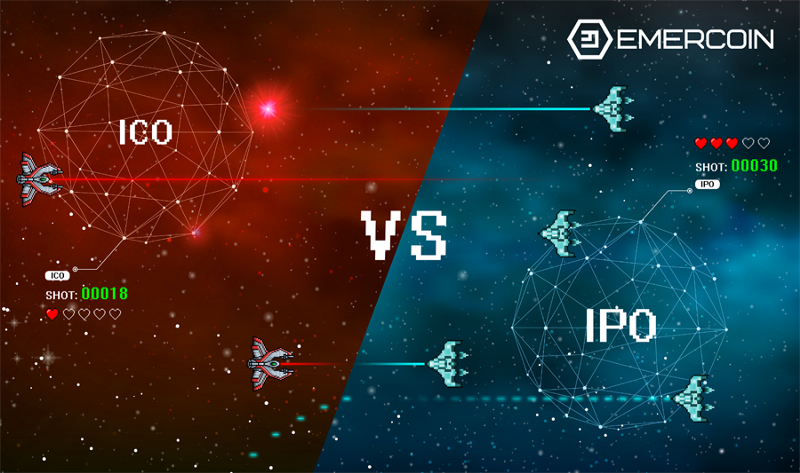ICO vs IPO: Where is the money, Zin?

Recently, the term ICO - Initial Coin Offer has become popular in a crypto environment. This term refers to the process of collecting investments for a particular project. Only instead of classic shares, participants are given “coines” - certain electronic tokens (entries in the blockchain) for their investment contribution, which confirm the investor’s share in the project’s ownership and, accordingly, its share in the profit from the project. In other words, Coin A is issued for Project A, Coin B is issued for Project B, and so on. Coin, as well as stocks, have value only in the framework of the relevant project. It turns out that project Coin A does not affect the Project Coin B.
The ICO mechanism has a number of useful features, such as:
- Coins of ICO can be split up and, conversely, summed up. Just like regular cryptomonettes.
- Coins of ICO have the same anonymity as regular payment cryptocurrency units.
- Coins can be sold-bought on crypto-countertops, which, naturally, they will trade.
However, with all the attractiveness of the ICO mechanism, there is a significant omission. This mechanism is good for raising funds and launching a project, but it does not provide for a mechanism for distributing profits to shareholders from the project’s business, that is, sending out dividends. At least, this could not be found either in the relevant documents or in the speeches of the speakers.
')
It seems that the supporters of ICO make their plans only to the stage of receiving money. “Bought tokens - great! Your role is fulfilled, congratulations! Now you are investors! And we - raised money, and much more than invested in advertising, and now we can smoke bamboo in Hawaii. ”
Of course, we are far from claiming that all ICO members are fraudsters. In no case! Just most of the ICO-organizers are quite conscientious people. But still, they don’t think about the future, and do not build the prospect to the project phase “and what will happen if my business becomes successful and it will be necessary to distribute profits to the shareholders?” And if they do, they’ll console themselves with the ideas: buy ICOs at the stock exchange and, thus, raise the value of shareholders' assets. ” But this consolation is self-deception.
This cost-recovery strategy for shareholders has two major drawbacks:
- In the mechanism of the buyback of the Coins, there is a change in the shares of ownership, which is not happening in the classical system, where shares are separated from dividends.
- The liquidity of any ICOs is, by definition, lower than the liquidity of money. Because ICOs are a derivative of a project (company), and money is a derivative of the economy, that is, all companies combined.
In the latter case, the company has to “cross the spread” to repurchase, that is, to pay a margin for the difference between buying and selling an ICO. And the margin is quite considerable, due to the low liquidity of the ICO-coin, tied to a specific project. And the liquidity of the ICO-koin is lower than the liquidity of a universal coin tied to the economy as a whole.
For example, a company has N money to reward shareholders, but physically cannot repurchase it, because there simply aren't enough sale offers on the markets. After all, what is offered for sale in the markets is usually a fraction of a percent of the real volume of issued shares or coins. Practically, the low liquidity of ICOs will lead to price peaks in case of acts of redemption and rewarding the superprofits of speculators, those who “leaked” on time, rather than real investors who buy for years and want to regularly make profits from investments.
So, we see that ICO is good for starting a risky project that has no profit and - accordingly - dividends. The game goes around the venture-type project, "and suddenly take off." Although it is known that 80% of startups go bankrupt during the first three years, and this or that investment mechanism cannot fundamentally affect these statistics.
For a real project that conducts business, has turnover and income, and regularly distributes profits in the form of dividends, the IPO mechanism is preferable.
It is from these considerations that Kolionovo’s peasant farm, under the leadership of Mikhail Shlyapnikov, chose an IPO mechanism for investment. At the time of the issue of shares on the Emercoin blockchain, the farm was already leading a real and profitable business, so the working dividend payment mechanism was a fundamental requirement when choosing a platform. The Emercoin blockchain has the ability to "send coins to the current unit holder." This allows you to effectively and quickly deliver dividends in the form of universal coins to the owners of the shares, thereby avoiding the intersection of the spread and "shaking the market." Here, the Emercoin blockchain performs two functions:
- distributed register of shareholders;
- mechanism for sending dividends to current shareholders.
At the same time, Kolionovo conducted an ICO for one of her projects, successfully testing alternative investment mechanisms.
In addition, it should be noted that the mechanism of IPO registered entries in the case of legal disputes can be reduced to a mechanism of IOUs like bonds (for these certificates are, in fact, IOUs, not only on paper, but on the blockchain), and thus if necessary, transfer property disputes to classical jurisdiction. The ICO mechanism is not legally defined anywhere, and the investor through the ICO is not protected by law. We also note that in the case of an IPO, the history of each unique record is traced, and in the event that an unauthorized transfer of a share is detected, the issuing company may refuse to service it, replacing another share in favor of the legal owner. In the case of anonymous ICO tokens, this is basically impossible.
The table below summarizes the above:

Source: https://habr.com/ru/post/328830/
All Articles